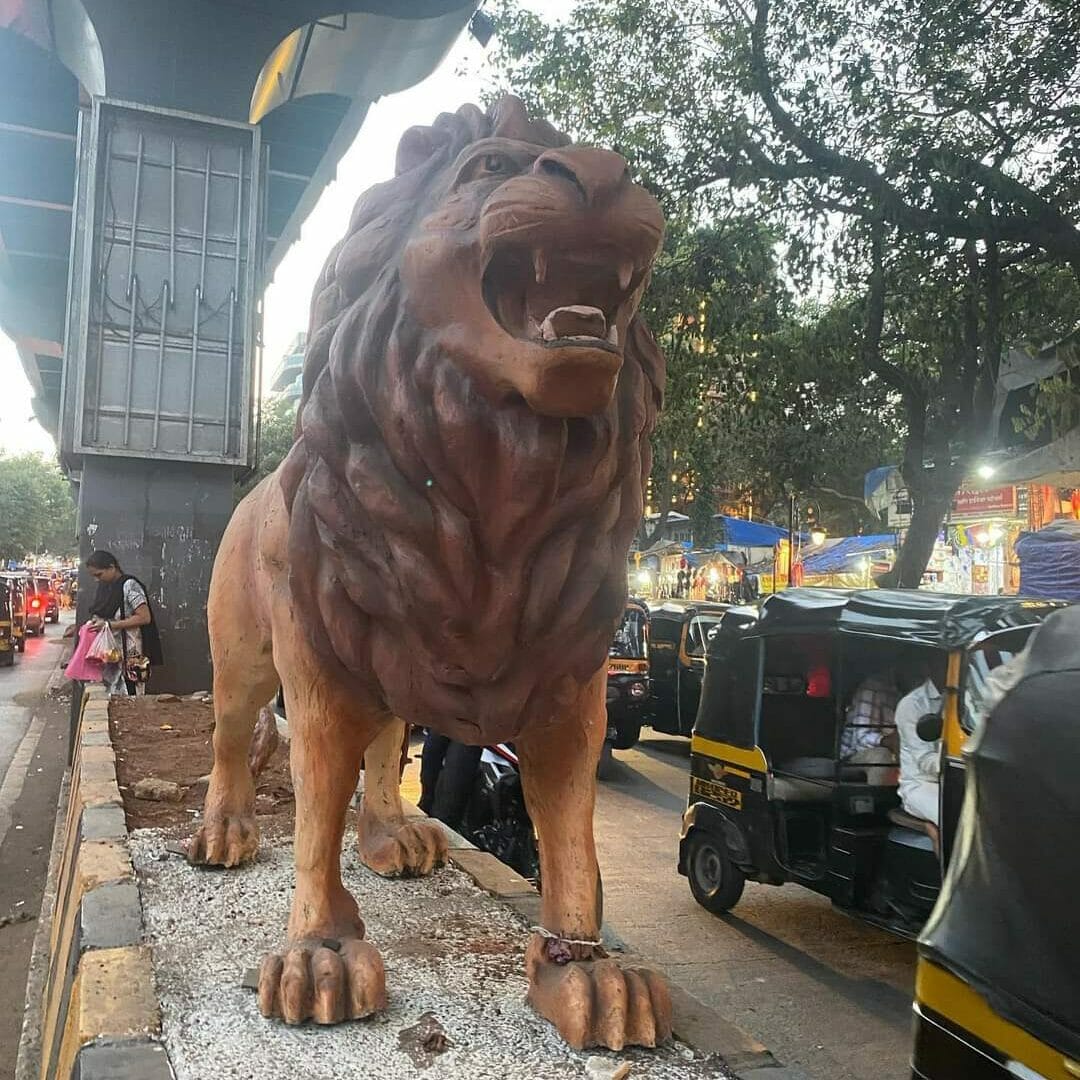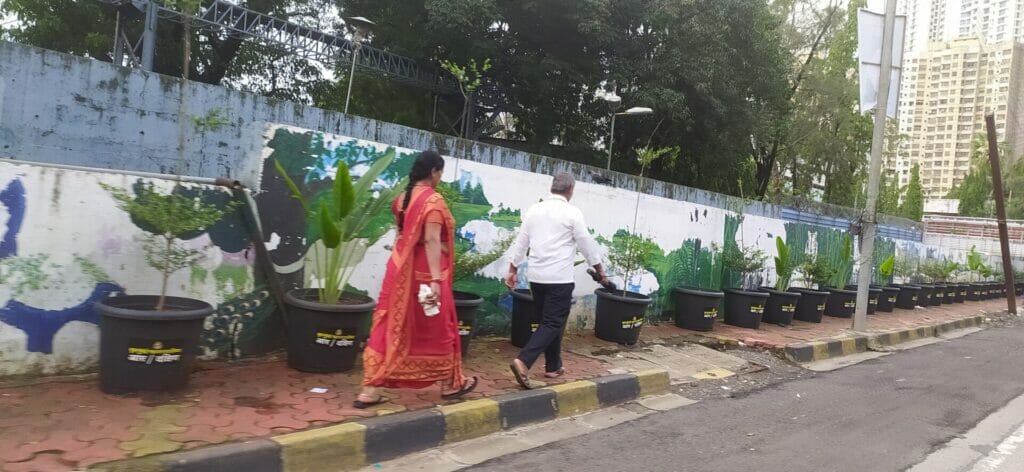On December 9, 2022, Maharashtra’s chief minister Eknath Shinde inaugurated a Rs 1729 crore beautification drive for Mumbai to spruce up the city to international standards.
With a sizeable amount of funds, people assumed that city infrastructure would be improved with repairs and renovations. However, six months into the process, to their dismay, citizens have witnessed wall paintings, animal installations below flyovers, well-maintained road medians being redone, garish, multi-coloured lights over street lights, paver blocks on footpaths being replaced with cement blocks apart from trees being decorated with electric lights and painted with oil paints.
Cosmetic changes as beautification project
Municipal administrator of Mumbai Iqbal Singh Chahal told Hindustan Times that BMC had already spent around Rs 720 crore for this beautification exercise. A total of Rs 275 crore has been spent for illuminations of roads, bridges, footpaths, streets and gardens and Rs 51.17 crore for illumination of skywalks in city and suburbs, Rs 140 crore for resurfacing and redoing road toppings under beautification and another another Rs 97.04 crore for makeover of footpaths.
The beautification plan included works such as resurfacing of roads, repaving and beautification of footpaths, traffic islands, dividers, bridges and spaces under bridges. Apart from that decorative lighting of beaches, gardens, forts, beautification of Gateway of India, digital advertising boards and urban forestry initiatives were also planned. The municipal commissioner had mentioned an estimated expenditure of Rs 1729 crore, in his 2023-24 budget speech.
Read more: Beautification project will not address the real concerns of Mumbaikars
Expenditure without vision
There has been overwhelming public criticism about the wasteful public expenditure without long term planning. “The BMC seems keen to convey the message that their coffers are overflowing and literally need to be offloaded on the streets. Each of the 24 wards in the city were allocated time-bound budgets for beautification. Under pressure, the ward officers scrambled to spend in any which manner, resulting in mindless lighting up all over the place,” says Zoru Bhathena, citizen activist, who closely monitors the functioning of the BMC.

“I recall seeing red LED lights being put up at a signal, where the signal itself wasn’t working. At other places, fairy lights were wound around streetlights in a locality, where the basic electricity supply itself was erratic. Just goes on to show that basic issues are not being fixed. Instead, the purpose seems to be to just use up certain budgetary allocations. Is our city saying that we have excess revenue that definitely needs to be spent?” says Zoru. Officials, he says, are wary or reluctant to share information about the budget of these works.
Ignoring basic city maintenance
“Each ward office was allocated Rs 30 crore, which could be spent on any beautification project in consultation with local citizens or their representatives broadly in categories like beautifying traffic islands or spaces below flyovers, painting walls or lighting up streets. As on June 15, 2023, of the 1181 works undertaken in the city, 846 works have been completed,” informed deputy municipal commissioner (special) Sanjog Kabare.
To put it into context, every year each of the 227 corporators in Mumbai receive Rs 2 crore as infrastructure funds and Rs 60 crore as maintenance funds for carrying out work as per their discretion. “Since the BMC corporation has been dissolved, many jobs are not being carried out by the local officials citing lack of funds. However, money is being wasted on unnecessary projects that are of no use or value to local residents. Shouldn’t money be spent on improving basic city infrastructure projects along with its regular maintenance and upgradation?” asks Arif Zakaria, former corporator from Bandra, who served three terms in the BMC’s standing committee.

He cites the example of how regular maintenance and cleaning up of Bandra’s Chimbai beach was ignored even as huge amount of money was spent in the name of beautification. “Such wasteful expenditure is being carried out, when clearly there is a crying need for basic infrastructure in the city being to be repaired. Cosmetic measures like touching up or whitewashing of walls won’t work in a city like Mumbai, where the basic infrastructure is already crumbling owing to overpopulation,” says Zakaria.
Read more: Mumbai: City planning leaves few open spaces for citizens to breathe free
Social media backlash
The beautification drive has been criticised severely on social media. Zoru Bhathena’s Facebook page of May 17, 2023 when he shared about the oil painted trees was met with overwhelming criticism about the drive. The twitter feeds of active citizens described the beautification drive as brainless, ugly and unnecessary and even “an eyesore” that takes away the beauty and aesthetics of the city .
Many prominent citizens have also lodged their criticism about the beautification drive actually being a waste of precious resources on their social sites like journalist Preeti Sompura here and others here, here and here. “Lights on a flyover and skywalk are so bright and colourful that it reminds me of a Chandni bar,” writes journalist Preeti Sompura on her FB post, a view shared by no less than cartoonist-politician Raj Thackeray, who found Mumbai resembled a dance bar with those lights on streetlight poles.
Zero citizen involvement
However, what pains Alan Abraham, co-founder of Mumbai Architects Collective and Bombay Greenway is how the drive marks the beginning of a disturbing trend – that of delinking citizens from having their say or stake in the city. “Citizens now have no clue about what may come up where and when in their own neighbourhood,” he says. He wonders that “If Mumbai wants to be comparable to any developed international city, then they should follow similar protocol in implementing projects. Abroad, there is a Town hall held before any new project, where citizens are informed and educated about projects and their opinions and suggestions are taken into consideration,” says Alan.

For Alan, the biggest issue is about lack of transparency about the long-term ancillary costs, such as the electricity costs or the regular upkeep and maintenance expenses. He feels that spending Rs 720 crores for an underdeveloped city like Mumbai that is lagging behind on basic indicators compared to other international developed cities was an “opportunity lost”.
This had caught the critical eye of Maharashtra’s opposition leader Ajit Pawar, who termed it a corrupt practice on the part of the BMC to “undertake works worth hundreds of crores of rupees without proposals and approval of elected representatives.” Pawar alleged that the government was using its power to influence the administrator to get the jobs done in the absence of elected representatives.
How can the city be beautified instead?
Beautifying a city could be done with minimal or even no funds, feels Alan. “Simple walkable footpaths on clear, well-planned and lighted roads without potholes or puddles are beautiful for a city. How much would it cost to remove ugly banners adorning roads? Clean toilets can also be beautiful for a city because they are helpful for citizens. The Tokyo Toilet Project involved many renowned architects and many brands chose to be associated with it. All functional elements in a city can be beautiful,” he says.
Ecologist V. Shubhalaxmi, founder of Inaturewatch Foundation feels that street art must be done in a way such that it “resonates with the city’s culture, is sustainable and gels with the local environment.” She cites the example of Maryland, US where street art is done aesthetically.
Wasteful expenditure, zero public involvement, lack of clarity on maintenance and recurring costs like power has disappointed citizens, who would much rather experience better quality footpaths, roads and public spaces that are done in keeping with the city’s heritage and aesthetic values.